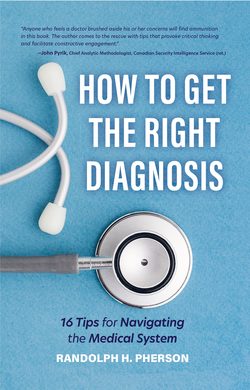Читать книгу How to Get the Right Diagnosis - Randolph H. Pherson - Страница 8
На сайте Литреса книга снята с продажи.
ОглавлениеForeword by Sandy Ibrahim, MD
In medical school, one of the questions I was taught to ask a distressed patient was, “Do you have a sense of impending doom?” What a silly thing to say, I thought. Who even talks like that? I have labs and tests that will answer that question better. ECGs, for example, can tell me much more than a patient could ever relate. I practice in the nation’s capital, and it is easy to send a patient down the street for fancy imaging, nuclear tests, or even the “million-dollar workup,” paid for by his insurance.
That being the case, why would I ask such a ridiculous question? Why would I put my diagnosis at the mercy of a patient’s answer to this outdated textbook question? Who would know best? The patient or a trained physician?
By the time Randy Pherson walked into my office, I had run out of diagnostic testing options that would explain his ever-persistent shortness of breath. We had spent five years exhausting the pathways of modern medicine. I had sent him to multiple specialists who ordered scores of diagnostic tests and prescribed multiple treatments. Unfortunately, every path led to a dead end. So, I fell back to asking that old school question: “Does Randy exhibit a strange sense of impending doom?”
Asking that question likely saved his life that day. Randy was tired, frustrated, and at the end of his rope. His face had that look of impending doom, which I had learned about but never encountered until that day. I told him to drive immediately to an emergency room. He protested, saying he would go right after two appointments that afternoon. I countered in no uncertain terms: “You must pick a hospital and drive there now. Non-negotiable.”
Over the course of my career, I learned that no matter what diagnostic tools doctors have at their fingertips, the most important route to effective treatment is old-fashioned face-to-face communication, eye contact, and spending quality time with your patients. Specialists should treat the patient, not just order and process test results.
Randy and I are grateful that one emergency room doctor listened to him—although it took a lot of prodding. Physicians need to talk—and better yet, listen—to the patient. They should ask open-ended questions, despite time constraints. They should encourage patients to tell their story instead of just responding to their questions. Doctors need to review patients’ data, not just focus on their test results. They should pick up the phone and converse with specialists. Above all, doctors need to learn how to collaborate, brainstorm, and personally engage. It could prove the difference between life and death for those “tough” cases that comprise Randy’s “5 percent.”
Patients have much to learn from Randy’s story as well. They should take responsibility for their own bodies and embrace the concept of preventative medicine. Patients should get annual exams so their doctor has a baseline for tracking their health. The average primary care provider has over three thousand patients under his or her care, and it is hard to remember everyone. If you see your doctor annually to get that wellness exam, we will remember you when you return and need our help. The wellness visit is our opportunity to engage and learn about you and your lifestyle when you are well. When you come in with a medical problem—as in Randy’s case, with severe shortness of breath—then your doctor can better gauge the severity of your condition.
With Randy, the objective findings did not match the subjective complaints, but I knew him and saw him often for well visits and sick visits. That knowledge buttressed my confidence in my belief that something was very, very wrong. Doomsday wrong.
As a primary care provider, I am forever humbled by the limitations of modern medicine and amazed at the human body’s ability to adapt. What follows is Randy’s story of persistence, physical adaptation, and lessons learned in his (our) journey through the pitfalls of modern medicine. I am grateful he is here to share his story with all of you.
Sandy Ibrahim, MD
Medical Director, Inova VIP360
Fairfax, Virginia
January 31, 2019
